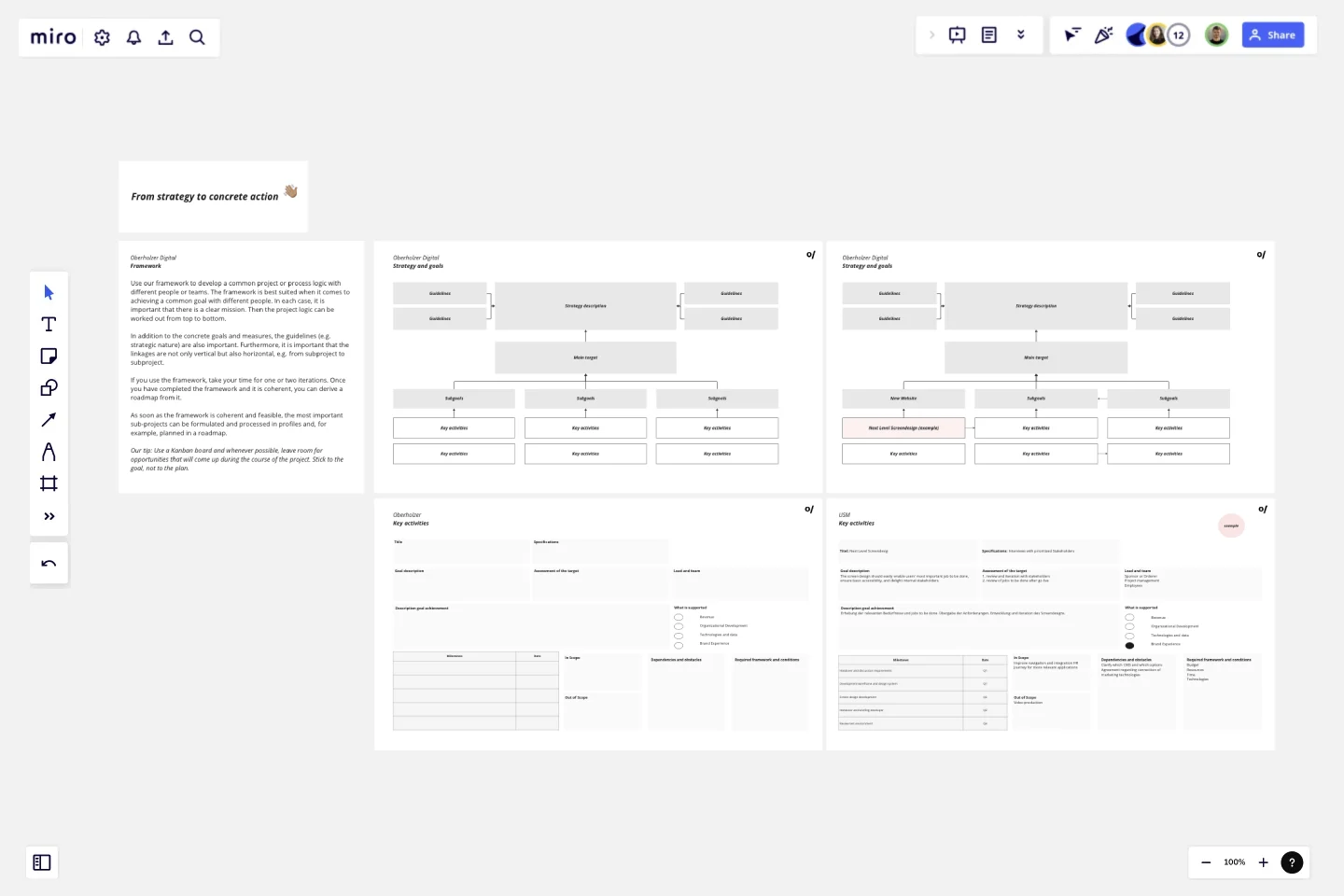Strategic Action Framework
Develop and implement strategic initiatives with the Strategic Action Framework template. Foster collaboration, drive progress, and deliver measurable results.
In addition to the activities, specifications that are to be integrated into the process can be included, for example. The Bigger Picture can also reveal conflicts or connections.
As soon as the framework is coherent and feasible, the most important sub-projects can be formulated and processed in profiles and, for example, planned in a roadmap.
This template was created by Klaus Oberholzer.
Get started with this template right now.
Agile Transition Plan Template
Works best for:
Agile Methodology, Agile Workflows
An Agile transformation roadmap can help you, your team, and your organization transition from rigid compliance-heavy methods to the more flexible Agile way of doing things incrementally. From requirements to integrations to security, you can map out your organization's moving parts as “swim lanes” that you can then update regularly. Use your roadmap as a way to tell the story of how you see your product growing over a period of time. Get buy-in without overselling and keep your roadmap simple, viable and measurable. By using an Agile transformation roadmap, you can avoid getting bogged down in details and instead invest in big-picture strategic thinking.
Fishbone Diagram for Marketing
Works best for:
Fishbone diagram
Identifying the root causes of marketing challenges is essential for effective strategy development. The Fishbone Diagram for Marketing template helps you systematically explore factors affecting your marketing efforts. Categorize potential causes into areas such as market research, product positioning, promotional strategies, and distribution channels. This structured analysis enables your team to pinpoint and address issues, optimizing marketing campaigns.
666 Roadmap Template
Works best for:
Strategic Planning, Product Management
For most companies, especially startups, it’s important to keep two perspectives in mind when planning for the future: your plan and your vision. Your plan is a close-up view of what you want to accomplish in the near future, while your vision provides a zoomed-out view of what you hope to accomplish in the long term. The 666 Roadmap encourages you to plan for the future by thinking about the next 6 years, 6 months, and 6 weeks. Use this roadmap to strategize, think about what you want to build, and focus on a concrete plan for the upcoming quarter.
Process Map Template
Works best for:
Agile Methodology, Product Management, Mapping
Process mapping allows you to assess, document, and strategize around any plan or approach your team has put in place. It’s a useful tool for eliminating or preventing blockers. Organized by stages, a process map enables your team to divide up a process or system and record deliverables and action items at each stage of the process. By breaking down the objectives, activities and deliverables at any stage of a project, you can gain insight into whether you are on track or effectively working through a problem.
Prioritized Product Roadmap
Works best for:
Roadmap, Mapping, Planning
The Prioritized Product Roadmap template enables teams to focus on delivering the most valuable features to customers. By prioritizing initiatives based on impact and effort, teams can maximize the return on investment and drive business value. This template fosters collaboration and alignment, ensuring that development efforts are aligned with strategic objectives and customer needs.
Product Development Roadmap Template
Works best for:
Product Management, Software Development
Product development roadmaps cover everything your team needs to achieve when delivering a product from concept to market launch. Your product development roadmap is also a team alignment tool that offers guidance and leadership to help your team focus on balancing product innovation and meeting your customer’s needs. Investing time in creating a roadmap focused on your product development phases helps your team communicate a vision to business leaders, designers, developers, project managers, marketers, and anyone else who influences meeting team goals.
